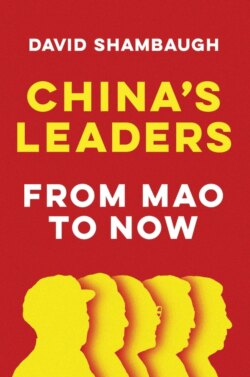Читать книгу China's Leaders - David Shambaugh - Страница 13
CHAPTER 1 ON CHINA’S LEADERS AND LEADERSHIP
ОглавлениеLEADERS MATTER IN ALL POLITICAL SYSTEMS—BUT IN SOME THEY MATTER much more. Leaders in totalitarian systems, or authoritarian leaders in single-party systems, are unconstrained by the checks and balances of democracies, and thus their actions are more determinative and have an outsized impact on their societies and the world beyond their borders. China is such a case.
This book assesses and contrasts the five main leaders that the People’s Republic of China (PRC) and the Chinese Communist Party (CCP) has had over its first seven decades: Mao Zedong, Deng Xiaoping, Jiang Zemin, Hu Jintao, and Xi Jinping. While a number of other leaders have served as President of the People’s Republic of China (PRC) and as Premiers (heads of government), this study focuses on the five principal Party leaders (Hua Guofeng, Hu Yaobang, and Zhao Ziyang will be folded into the Deng chapter, as their brief tenures at the top were not really long enough to merit separate chapters). The book is about the leadership styles of these five individuals, as well as about these men’s times and records as paramount leaders. Each had a distinctive leadership style: I characterize Mao as a populist tyrant, Deng as a pragmatic Leninist, Jiang as a bureaucratic politician, Hu as a technocratic apparatchik, and Xi as a modern emperor. These descriptions tell us not only about the individual leaders’ styles of rule, but also about different aspects of the Chinese political system itself. The main analytical approach is therefore to explore the intersection between each individual’s persona and style of rule with China’s developments domestically and internationally. Readers will therefore not only gain an (admittedly compressed) survey of the last 70 years, but one seen principally through the lens of the leader’s visions and actions during each period in power (Mao Zedong 1949–1976; Deng Xiaoping 1977–1989; Jiang Zemin 1989–2002; Hu Jintao 2002–2012; Xi Jinping 2012—). This book is primarily intended for students and readers who wish to gain an overview of the past seven decades of Chinese politics—in itself quite a task—but it is also a study for specialists who wish to dig inside the persona of each leader and try to understand how their socialization shaped their particular styles of rule.
One might assume that there has been much continuity of leadership style in a Leninist political system such as communist China. Actually, I find that there has been a considerable degree of discontinuity of style among these five leaders. This can be seen in particular in the different ways they each approached institutional bureaucracies of party and state, as well as varying differences over policies. Their differences are also evident in the manner that each performed their public roles, in how each approached the mass public, how each used the language of propaganda and ideology, and how each dealt with their contemporaries and subordinates. Each leader also approached the outside world and China’s foreign relations in different ways.
Of course, each ruled at a different period of time—and thus confronted differing sets of policy challenges at home and abroad. Each was born, reared, and matured professionally during different decades; this is why each is said to have represented five different generations of leaders (五代 的零售价). They also therefore faced different tasks: only Mao had to build a regime and country from scratch—all the others inherited a system and nation-state, to which their efforts can be said to have been additive and supplemental. Even though the system and country that Deng inherited from Mao had been deeply traumatized by the late Maoist era, the anarchy of the Cultural Revolution, and had to be rebuilt, the CCP and PRC nonetheless were well solidified by that time (1977). Deng’s reforms did nonetheless constitute significant qualitative changes, albeit within the existing systemic framework. The post-1989 (Tiananmen massacre) China that Jiang Zemin inherited from Deng, and the policy adjustments he made, were also a significant departure from the 1980s—yet these changes were more to the superstructure rather than the foundation of the CCP operating system. Hu Jintao made minimal incremental changes to the system, although he (and his Premier Wen Jiabao) did launch a number of social policy initiatives (which largely went unrealized). Xi Jinping has certainly been a strong leader—the strongest since Deng (some judge since Mao)—but, again, the changes he has made to the system have been largely additive rather than fundamental and original.
They have certainly shown commonalities as well. As with all Chinese leaders since the “self-strengtheners” of the late Qing dynasty (1870s–1890s), they sought to build China economically, make it “wealthy and powerful” (富强), to maintain its territorial integrity and sovereignty, to protect its national security, to recover its lost dignity and respect, and to strengthen the country’s position in Asia and the world.1 All also sought to continually strengthen the Chinese Communist Party institutionally (Mao and the Cultural Revolution being the major exception, although it can be argued that Mao too was trying to remake and thus reinvigorate the Party). As leaders of “new (socialist) China” (post-1949) they had the common vision of reducing poverty and social inequalities, increasing literacy and education, reducing the rural–urban gap, eliminating social vices, and maintaining social stability (the Cultural Revolution again being the exception). Yet the means and approaches for achieving many of these goals varied considerably among the five leaders. Thus, when conceptualizing the similarities and differences among these five leaders it may be analogous to think of a house or building where the foundation, walls, and roof remain the same—but the interior rooms and wiring were constantly being altered.
